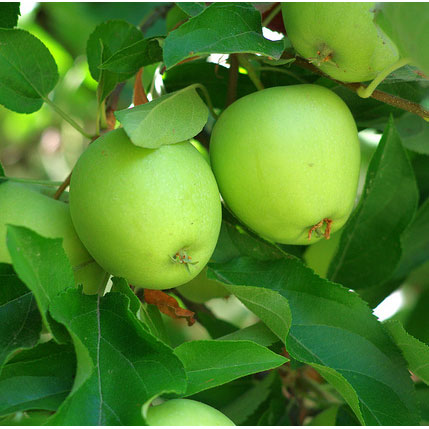
‘Granny Smith’ (GS) is the most widely planted apple cultivar in South Africa, accounting for 25% of apple plantings in 2008 ( Deciduous Fruit Producers’ Trust, 2009). Keywords: sunburn red blush chlorophyll fruit quality peel temperature GS may benefit significantly from the installation of shade netting if combined with rigorous pruning and vigor control. In conclusion, maximum chlorophyll synthesis and dark green color require an open canopy during the first half of fruit development, whereas shading is necessary during the latter half of fruit development to avoid the occurrence of sunburn, red blush, and photothermal destruction of chlorophyll.
#Granny smith apple color full
The 10% darkest green fruit received moderately high irradiance (25% to 45% of full sun PPF) during early fruit development (until ≈80 DAFB) but became progressively shaded (3% of full sun PPF) during the latter half of the season. Deeply shaded inner canopy fruit received ≈2% of full sunlight, had low chlorophyll concentrations, and were lighter green in color. Partially shaded fruit from the southern side of east–west rows received ≈5% of full sunlight and had the highest chlorophyll concentrations and darkest green color at harvest. Only 22% to 39% of exposed fruit from the outer canopy did not develop sunburn or red blush. A high proportion of exposed fruit from either side of the row developed red blush. Exposed fruit from the northern side of east–west rows received the highest irradiance throughout the season and had the highest fruit surface temperature (on average 5 ☌ above ambient). Good green color at harvest relied on exposure of fruit to high irradiance at this stage because 50% shading between 14 and 56 DAFB significantly decreased dark green color at harvest. During early fruit development, chlorophyll concentrations were the highest in fruit from higher light environments. This study was conducted to investigate the relationship between canopy position and external fruit quality with the ultimate aim to devise pruning and training strategies to maximize export yield. However, production of GS is becoming unprofitable as a result of a high incidence of sunburn, red blush, and pale green fruit that decreases the proportion of Class 1 fruit that is suitable for export to more lucrative markets. Remove suckers or any unwanted shoots at any time of the year.The dark green apple cultivar, Granny Smith (GS), makes up 25% of the South African apple industry.

Every year in late winter orĮarly spring give the tree a good trim to shape it and allow air flow betweenīranches. Until the tree is established, as well as pruning. Granny Smith apple care requires regular watering initially, Graft line is a couple of inches (5 cm.) above the soil line when planted. Work organic matter into the soil first if it needs more nutrients. Plant a new tree in a sunny spot with soil that drains well. Some good options include Red Delicious, Rome Beauty, and Golden Delicious as well as many crabapple varieties.

You’ll need another apple tree as a pollinator as well. When growing Granny smith trees, it’s best to be somewhere in zones 5 through 9, but this variety will tolerate heat better than many others.

It pairs well as a simple snack with cheese or peanut butter. You can also use Granny Smith in cider, pies, and other baked goods, and fresh or cooked in savory dishes. Enjoy them fresh and store for up to six months. Granny Smith is now among the most popular of apple varieties. Parentage, but apple experts suggest the Granny Smith resulted from a crossīetween a Rome Beauty and a French crabapple. The tree grew on her property in a spot where she tossed crabapples. The original Granny Smith was discovered by Australian MariaĪnn Smith. The apples can be enjoyed in any culinary use. Granny SmithĪpple trees are great for the home orchard because they provide these deliciousįruits in abundance.
#Granny smith apple color skin
It is famous for its unique, bright green skin but alsoĮnjoyed for the perfect balance of taste between tart and sweet.


 0 kommentar(er)
0 kommentar(er)
